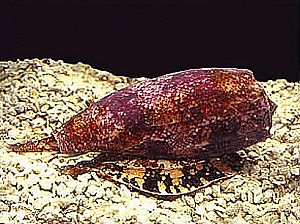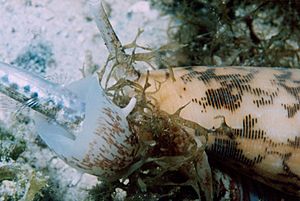Conus facts for kids
Quick facts for kids Cone snails |
|
|---|---|
 |
|
| Geography cone, Conus geographus | |
 |
|
| Conus species eating a small fish, in Guam | |
| Scientific classification | |
| Kingdom: | |
| Phylum: | |
| Class: | |
| Family: | |
| Subfamily: |
Coninae
|
| Genus: |
Conus
Linnaeus, 1758
|
| Type species | |
| Conus marmoreus Linnaeus, 1758
|
|
Conus is a large group of small to large predatory sea snails. They are a type of marine gastropod mollusc. People often call them cone snails, cone shells, or just cones.
As their name suggests, these snails have shells shaped like a cone. Many species also have very colorful patterns on their shell surfaces. Most Conus snails live in tropical parts of the world. You can find them in tropical and subtropical seas, from shallow areas near the shore down to depths of 1,000 meters. Their shells can look very different from one species to another. They vary in how bumpy their shells are, their colors, and their patterns. Many fossil cone snail species have been found. They first appeared a very long time ago, during the Cretaceous period.
All Conus snails are poisonous. They are hunters and eat marine worms or other molluscs. The larger cone snails can even catch and eat small fish that live on the seafloor. Cone snails use a special, hypodermic-like tooth, which is part of their radula, and a venom gland. They use this system to attack and paralyze their prey before eating it. This tooth is often compared to a dart or a harpoon. It has barbs and can be extended quite far out from the snail's mouth, at the end of a tube called a proboscis. Because they can "sting" humans, it's very important to handle them with extreme care, or even better, not at all.
The venom of cone snails is mainly made of small proteins called peptides. This venom contains many different toxins, and each one has different effects. Some of these toxins are extremely dangerous. A sting from a small cone snail might feel no worse than a bee sting. However, the sting from some larger species can be very serious and has even been fatal to humans in some cases. According to a book called Goldfrank's Toxicologic emergencies, only about 15 human deaths have been caused by cone snail stings.
Scientists are very interested in cone snail venom. It shows great promise as a source for new substances that could be important in medicine.
Contents
Cone Snails: Ocean Hunters
Their Amazing Shells
The shells of Conus snails are usually thick and shaped like an upside-down cone. The top part of the shell, called the spire, is short and can be smooth or bumpy. The opening of the shell, called the aperture, is narrow and long. It has straight edges and is cut off at the bottom. The snail also has a very small lid, called an operculum, compared to the size of its shell. This lid is made of a tough, horn-like material.
Venom and Medicine
Cone snail venom is a mix of many different tiny proteins. These proteins are called peptides. Each peptide can affect the body in a different way. Some of these peptides are very strong and can be used to create new medicines. For example, some might help with pain relief, while others could be used to study how nerves work. Scientists are still learning a lot about these amazing venoms.
Images for kids
See also
 In Spanish: Caracoles cono para niños
In Spanish: Caracoles cono para niños


